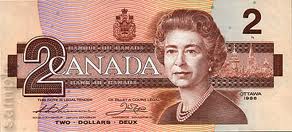Want to learn more about the Canadian one dollar bill? Read on for facts and info about the one dollar bill of Canada…
The odyssey of the Canadian dollar bill starts back in 1841 when the then province of Canada decided to link the value of its official currency, the Canadian Pound, to the US dollar. The value was adjudged to be equal to one-tenth of a United States ten-dollar Gold Eagle coin. The Eagle had seventeen and a half grams of twenty-two carat gold.
There were to be five shillings in the Canadian pound and by linking its value to a standard gold coin, conversion rates with other currencies in the world were also easily determined. A British sovereign of the era was thus adjudged to be equal to one Canadian pound, four shillings, and four pennies.
Transitioning from the Pound to the Dollar
The Canadian government decided to adopt the decimal system in currency starting from 1958 and converted the local currency to dollars, each dollar worth one hundred cents. The value was fixed to that of the US dollar then valued at a little over one-and-a-half ounces of gold.
The other crown colonies that joined the Canadian Confederation in the nineteenth century also adopted the Canadian dollar system. Some issued their own currency till later with Nova Scotia holding out until 1871 and Newfoundland issuing its own coinage until 1949. However, the value of the currencies of all provinces was standardized to be equal to the national Canadian dollar by the end of the nineteenth century.
The Uniform Currency Act of 1871 had standardized the Canadian dollar and in 1933, the gold standard was finally abandoned and the Canadian dollar was de-linked from the US dollar by 1950. It was linked again in 1962 but has been allowed to float freely since 1970.
Old Canadian Banknotes
The British Army had issued one dollar and higher bills during the War of 1812 with the United States. Montreal Bank issued the first banknotes in 1817. Other banks also intermittently issued banknotes dropping the pound notes for good in 1958. The Dominion of Canada upon Confederation started issuing banknotes in 1870 including the one-dollar bill.
Bank of Canada Dollar Bills and The Death of The One Dollar Banknote
The Bank of Canada was established in 1934 to regulate the country’s currency. The original 1935 series one-dollar bill was printed either in English or French and the layout was the same as for other denominations. This was followed in turn by the 1937 series, the 1954 series, the 1967 series, and the 1969-1979 Scenes of Canada series.
The Canadian one-dollar bill was last printed in 1989 and is no longer in circulation. The Canadian “loonie” coin (so named because it has a picture of a loon on one side) has completely supplanted the banknotes. The one dollar coin had been issued since 1935 but not with the loon. These days you can only get the Canadian bills in $2, $5, $10, $25, $50, and $100 denominations.





